To celebrate the release of Star Trek: Into Darkness this month, we’ll be running through the first season of the classic Star Trek all this month. Check back daily to get ready to boldly go. It’s only logical.
I’ve talked about it about it quite a bit in my earlier reviews, so I won’t dwell on it too much here, but Star Trek got really good really quickly. Balance of Terror is only the ninth ever episode of Star Trek ever produced, but it stands as one of the finest entries in the original series, and perhaps even the franchise. It also represents the moment where the model of what Star Trek would be really sort of solidified. The first eight episodes had contained any number of classic Star Trek tropes.
The Cage and Charlie X gave us old and immeasurably powerful alien civilisations, while Where No Man Has Gone Before gave us a god-like being. The Man Trap gave us space monsters. Mudd’s Women gave us awkward gender politics. The Enemy Within created the whole “transporter malfunction” and “evil duplicate” subgenres. However, Balance of Terror is the first episode to suggest outer space might be more than the place where crazy stuff happens and our heroes bump into monsters or ancient civilisations. The universe might have its own politics, its own history, its own civilisations that will emerge, contrasted with mankind’s expansion into space.
The Klingons are undoubtedly the most recognisable and iconic of the classic Star Trek races, but the Romulans are the first of the franchise mainstays to appear, and Balance of Terror is the first episode to devote considerable effort to world-building the Star Trek universe.
The early episodes of Star Trek were a bit of a mess. Even internal continuity was hard to come by – and I’m not even talking about the colour of the shirts that Scotty and Sulu wore. The “United Federation of Planets” would not be formally identified until A Taste of Armageddon. Even the first hints of the characters serving a “Federation” would only emerge in the twentieth episode of the season, Arena.
Before that point, it seemed like the Enterprise was just an “Earth ship.” There was little indication that the Enterprise was part of a vast political body populated with countless other alien species. Spock’s presence on the ship seems like an exception, and it’s quite clear that the rest of the ship’s crew is exclusively human. In Where No Man Has Gone Before, Kirk speaks as if Earth is its own political entity. Even in Charlie X, Kirk reported to the “United Earth Space Probe Agency.”
So far, the show has presented space as barren and empty, almost haunted with terrors stalking in the darkness. Space is, to borrow a quote from another iteration of a character here, “disease and danger wrapped in darkness and silence.” Okay, maybe not so much silence, but it’s an apt remark otherwise. There’s a sense in these early episodes that the Enterprise is stalking through a universe decorated with the remains of dead (or soon-to-be dead) civilisations.
While some of this attitude remains part of Star Trek throughout the franchise’s life, it does get superseded by the idea that space is also populated with exotic and interesting new lifeforms with their own philosophies and ideals. Balance of Terror is a major step in that direction, establishing an alien race that appears to be roughly at the same stage of development as Earth, and one that seems at a comparable level of power.
More than that, Balance of Terror is the first episode to suggest a complex mythology underpinning the Star Trek franchise, something a bit more exact and precise than “… and then we were in space.” While it is shrewd enough not to give exact dates (sorry, Space Seed), Balance of Terror gives us a look at the history of this version of the human race, establishing a vast “Neutral Zone” separating us from a historic enemy, a zone “established by treaty after the Earth-Romulan conflict a century ago.”
We discover that not only do we have a history in space, but that we also involved ourselves in some conflicts. The presence of Spock on the bridge suggests that we have made friends with the Vulcans, but it’s clear that they aren’t the only alien species we have encountered on our path to the stars. The mythos isn’t even nearly developed at this point, but Balance of Terror is the first indication that it exists, the first sense that there’s a back story behind Star Trek than amounts to more than “wagon train to the stars.”
Indeed, we even get some development for the Vulcans, at the point where we have yet to even encounter a full-blooded Vulcan. It is worth noting that the first major space-faring race encountered in Star Trek is immediately established as something of an evil twin to the Vulcans. As Spock explains, the Romulans are the product of a schism. “Vulcan, like Earth, had its aggressive colonising period. Savage, even by Earth standards. And if Romulans retain this martial philosophy, then weakness is something we dare not show.”
Even this early in the show, Spock has already demonstrated that the Vulcans represent a lot of the ideals that Roddenberry strove to integrate into the show. They are peaceful, wise, intelligent and they are not governed by base desires or emotions. They represent the best of our potential at this point in the show’s history – more of a fuzzy ideal than a developed culture in their own right. So the Romulans represent a dark mirror to that potential. It’s telling that the Romulans are obsessed by warfare and that they are still using atomic weapons. If the Vulcans are the best in us, the Romulans represent perhaps the worst.
And yet Balance of Terror is not too different from the episodes surrounding it. Despite introducing another galactic power to rival what would be established as the Federation, Balance of Terror subscribes to the idea that space is a barren wilderness just as much as Mudd’s Women or Charlie X. Gene Roddenberry famously pitched the show as a western… in space, but the truth is the show did all manner of classic adventure genres with a science-fiction twist.
Charlie X was the story of a feral child raised away from society, not too different from Tarzan with god-like powers. Where No Man Has Gone Before was about a ship adrift at the edge of the world, dealing with a threat from within the crew. Balance of Terror borrows from another classic genre, essentially allowing Star Trek to offer its own take on submarine warfare. Writer Paul Schneider has confessed that Balance of Terror is an adaptation of the classic submarine war film The Enemy Below.
However, it’s more than just the allusions to a vintage war story that make it clear Balance of Terror is set in a cold and remote universe. The show’s lighting is noticeably dimmer, but that isn’t necessarily it either. Most science-fiction tends to under-estimate the sheer vastness of space, to assume that objects in the void must be reasonably close together, even with the ability to travel faster than the speed of light. In Balance of Terror, that distance is keenly felt.
Kirk and the Enterprise can’t make it to an attacked outpost in time. They can barely make it into range of real-time conversation before the outpost is destroyed. Kirk can’t communicate with his superiors. He’s very clearly acting on his own best judgement, at the edge of Earth’s reach. Half way through the episode, he seeks to send a message to his commanders. “Lieutenant Uhura, inform Command base, In my opinion, no option. On my responsibility, we are proceeding into the Neutral Zone.” He only receives a response to his message at the end of the episode, after the threat has passed.
Despite the presence of the Romulans, there’s a sense that there’s little else of note in this entire region of space. Kirk notes that the Enterprise is “patrolling outposts guarding the neutral zone between planets Romulus and Remus and the rest of the galaxy.” Given that a deliberate attempt is made to contrast the Romulans with the Federation, it seems strange that the only planets of note on the other side of the Neutral Zone are Romulus and Remus.
A brief shot of a star chart demonstrates that the Neutral Zone isn’t just a circular cordon around these two planets, hemming them in. It’s a border that seems to divide two comparable power blocks. And, as such, it suggests Romulus and Remus are the only points of interest in that particular direction. Even the outposts monitoring the Neutral Zone aren’t on planets or free-floating in space. Instead, they are build on asteroids, barren chunks of rock floating in the empty cosmos.
What’s interesting about Balance of Terror, as pointed out by the wonderful Ronald D. Moore, is the way that it really breaks a lot of the rules that Roddenberry would go on to establish as part of Star Trek. In fact, what makes Balance of Terror such a fantastic episode is precisely what would be missing when Roddenberry produced the troubled first season of Star Trek: The Next Generation. These aren’t perfect people, cast in the mold of Roddenberry’s ideals. There’s racism here. There’s even religion, as Kirk officiates over an almost-wedding in the ship’s chapel.
That last part is especially interesting. As I’ve noted before, Roddenberry was an avowed athiest. And a lot of that bled into Star Trek, becoming a lot more explicit during his time working on The Next Generation. His distaste for organised religion is quite clear even in the original series. After all, most god-like beings on Star Trek tend to evil, petulant or strangely disconnected from what goes on around them. Instead, Roddenberry preaches a secular humanism through Star Trek.
However, Star Trek is also about respecting differences, and the chapel on the Enterprise seems to acknowledge the value that religious belief holds for people. There’s a lovely line, as Kirk reads his scripts, stating that the ceremony is held “in accordance with our laws and our many beliefs.” It’s a nice touch, acknowledging that even if you don’t belief in any religion – and even if the organisation is largely secular – it can acknowledge and respect religious beliefs. It’s quite similar to the respect show to the Bajoran religion on Star Trek: Deep Space Nine, and quite far from the condescension adopted by episodes like Justice.
Balance of Terror recognises that the ideals of Star Trek aren’t affirmed if they are rendered part of an inviolable status quo. The fact that the cast of The Next Generation are essentially perfect human beings might make them fascinating thought experiments, but it doesn’t make them compelling protagonists. To borrow a quote from another spin-off, “it easy to be a saint in paradise.” The true beauty of the Star Trek ideals in watching our leads struggle to reconcile them and fight to uphold them.
Here, for instance, we witness that racism and xenophobia are not entirely divorced from the human condition. It was alluded to in The Corbomite Manoeuvre, with Bailey’s reaction to Balok. In this case, Stiles finds himself fighting to overcome his own generational prejudices – scars left by ancient wars and old grudges. Stiles’ anger isn’t directed at some external tormentor. It is rendered all the more ugly for the fact that Stiles channels his hatred towards Spock, already an iconic part of the series.
It’s only be acknowledging and tackling our own insecurities and shortcomings that we can overcome them, and that’s the reason why I’ve felt that Roddenberry’s later overly-sterile approach was self-defeating. It’s fine to pretend that humanity is perfect and have us travel the cosmos lecturing those we deem less advanced (as in The Last Outpost or Lonely Among Us), but it’s another thing to admit our own failings.
And the truly optimistic part of Star Trek isn’t that somehow we’ll have one day transcended all that. It’s actually getting a bit more specific, rolling up our sleeves and actually transcending them right now. The message of Star Trek isn’t that one day everything will be perfect, it’s that mankind is actually capable of great and impossible things. The beauty of Balance of Terror isn’t that it presents a future without prejudice, but it offers a future where we can move past that prejudice. As Kirk advises Stiles when he talks of a century-old conflict, “Their war, Mister Stiles. Not yours. Don’t forget it.”
And then there’s the Romulans. The Klingons are more ubiquitous, but the Romulans are my favourite of the aliens to originate in the classic Star Trek. What’s great about Balance of Terror is that it takes the time to develop these aliens. Not in a generic world-building sort of a way, but in demonstratingt hat we’re really not too different despite it all. While Spock might describe the Romulans as “warlike, cruel, treacherous”, but that’s just the human impression of them. By the end of the episode, Balance of Terror trusts us to acknowledge that the Romulans are much more than those clichés.
Indeed, the Romulan ship – despite the anonymity of the ship and its commanding officer – are very clearly intended to mirror the Enterprise. Both ships are the “flagship” of their respective power. Kirk and the anonymous enemy commander are evenly matched because they can read and understand each other. “He’s a sorcerer, that one,” the Romulan commander muses. “He reads the thoughts in my brain.” When the Romulan evades one trap, Kirk concedes, “He did exactly what I would have done.”
As the commander acknowledges at the end of the episode, “You and I are of a kind.” It’s interesting to note that while Kirk (and the audience) never learn the Romulan’s name, the Romulan also never learns Kirk’s name – even during that final face-to-face communication. They are both anonymous to each other. It’s a nice and subtle piece of characterisation, and one which underscores the themes of Balance of Terror beautifully. The only reason to root for Kirk over his opponent is because we know Kirk.
The Romulan commander is a fantastic character, and it’s little wonder that the show couldn’t wait to bring back Mark Lenard. The guy is sympathetic despite the ship’s unprovoked attacks on Federation outposts. There are any number of nice moments and touches, like the commander’s appraisal of a comet the ship passes on the way home. “How pleasing to the eye it is,” he poetically observes. “Behold a marvel in the darkness.” It’s very clear that the Romulan commander doesn’t want any more blood shed than is strictly necessary. He just wants to go home. Lenard perfectly captures his resignation when, finally disabling the Enterprise, he remarks, “Now we go home.”
It helps that the episode makes it clear that the Romulan commander does not want war. He is just following his orders and obeying command directives like a good soldier. “No need to tell you what happens when we reach home with proof of the Earthmen’s weakness,” he remarks to his trusted colleague. “And we will have proof. The Earth commander will follow. He must. When he attacks, we will destroy him. Our gift to the homeland, another war.”
There’s a sense of fatigue and exhaustion in the commander’s voice, the bitterness of a man who sees through the empty patriotism and viscious nationalism. When the centurion points out that this is the way the world works, the commander lets his frustration vent. “Must it always be so? How many comrades have we lost in this way?” The commander’s cynicism and grounded realism is contrasted with the aggression of his younger officer, Decius, clearly excited by this “glorious mission.”
It’s an interesting idea that Balance of Terror touches upon, and one that probably felt quite timely in 1966, and still feels relevant today. There’s something interesting as how society deals with the legacy of warfare – how we relate the concept to a generation that has never quite lived through the horror itself. There’s an argument to be made – similar to the argument that Ted Harrison recently made about Remembrance Day in Great Britain – that war is almost glorified by those two young to remember it.
It’s perhaps quite telling that the average age of those killed in Vietnam and during the Second World War was in the mid-to-low twenties. Most soldiers will typically be drawn from the young male population, and there’s roughly a twenty-year gap between most major American ground conflicts. (The major exception is the Korean War, also known as “the Forgotten War” or “the Unknown War” due to its relatively low profile.) Typically those soldiers serving in combat would not be young enough to remember the horror of warfare.
The First World War ended on the 11th of November 1918, with the Treaty of Versailles signed in June 1919. The Second World War broke out two decades later, on the 1st September 1939, and ended with the surrender of Japan on the 2nd September 1945. Balance of Terror was broadcast in 1966, another two decades following the end of that conflict, with the spectre of nuclear annihilation looming in the background and perhaps afraid that another major world conflict might be awaiting a generation too young to have lived through the Second World War.
It seems that Decius is a man too young to remember a major conflict. He speaks in patriotic terms of abstract concepts like “glorious battle”, and seems to genuinely long for a conflict that may prove his worth – in fact, it’s telling how frequently and earnestly Decius uses the phrase “glorious” to describe something that the Romulan commander recognises as bleak and terrifying. After the Romulans have incapacitated the Enterprise, the commander is willing to go home. In contrast, Decius is driven by patriotic bloodlust. “And it is our duty to crush the Praetor’s enemies,” he informs the commander. It is this decision that ultimately dooms the ship.
It is interesting to note the characterisation of the Romulans throughout the original Star Trek feels a bit more like the way that Klingons would come to be treated by the franchise from The Next Generation onwards. While Spock’s comments about Romulan treachery might apply to the Romulans of the later era, Balance of the Terror and The Enterprise Incident both define the Romulans as creatures of habit and honour.
The Romulan commander would rather destroy his ship than surrender to Kirk, something the episode acknowledges as honourable conduct. “We are creatures of duty, Captain,” he explains. “I have lived my life by it. Just one more duty to perform.” While lamenting the inevitable war that his mission will spark, the Centurion advises his colleague, “Our portion, commander, is obedience.” The commander regretfully admits that he hopes the mission could fail, but his honour would not allow it. “Centurion, I find myself wishing for destruction before we can return. Worry not. Like you, I am too well-trained in my duty to permit it.”
While the Romulans of the original Star Trek act more like the Klingons from later adventures, it’s also worth noting that Klingons were portrayed in a style more in keeping with the portrayal of Romulans in The Next Generation. In episodes like The Trouble With Tribbles, Private Little War, and Friday’s Child, the Klingons would try to subtly undermine the Federation’s influence through subterfuge and covert actions – a far cry from the honourable aliens established in Heart of Glory.
There are a few contrivances that are necessary to get the plot to work properly. It seems a bit convenient that nobody has ever seen a Romulan – whether dead or alive – and that nobody has noted the similarities between the Romulan language and that of Vulcan. You could argue that the fact that Vulcan clearly never really mentioned that they have a bunch of warlike cousins foreshadows the portrayal of the Vulcans in Star Trek: Enterprise.
Similarly, it dis just as lucky that Uhura can hack into the Romulan ship’s bridge in time to give us a suspenseful reveal of the fact that these Romulans have… pointed ears! Truth be told, I don’t mind these sorts of contrivances. Balance of Terror is interesting and clever enough that these plot points don’t distract or impede too much – proof of what the show can get away with if it has enough good ideas to keep a script moving forward through those sorts of problems.
Balance of Terror is a genuinely classic piece of television, and an example of Star Trek operating at its very best. It’s a gem of an episode, and one that demonstrates that Roddenberry’s ideals work best when put under pressure. It’s also the first genuine attempt at world-building that we’ve seen so far, and one that would play a significant part in defining the future of the franchise. It’s the first real indication the audience has been given that the Star Trek universe has its own massive and complex history, and that Star Trek is more than just an adventure show, but an exploration of a well-defined and complex world.
I’ll confess that I’m generally not to bothered with the particulars of continuity. I like character continuity, but I won’t get to bothered if a few details in a forty-seven-year-old franchise don’t match up – and I generally don’t subscribe to the idea that a piece of fiction should ever measure its worth by its “importance” to a particular form of continuity. A good story is a good story, regardless of its place in this grand web of storytelling.
However, even I’ll concede a geeky regret now and again. I’ll admit that my one real problem with the reboot of Star Trek in 2009 was the fact that Balance of Terror could never really happen in anything resembling the same way. Other stories could be told without changing too many core details, but Star Trek made Balance of Terror a story that could never really unfold in this new Star Trek universe. And that made me a little sad.
Of course, it’s not a serious problem. It’s not something I hold against the movie in an sort of sincere manner. It certainly doesn’t affect my enjoyment of this episode. I just thought it was quite telling that my immediate reaction to the Star Trek continuity reboot was to evaluate it in terms of this episode. If Balance of Terror isn’t quite my favourite episode of Star Trek, it certainly ranks among them. It’s just a stellar example of what could be done with the franchise.
Appropriately enough, given its status, Balance of Terror was the first Star Trek episode to be remastered. I’ll confess to being a little disappointed with the remastered effects on the adventure. While it might have been very easy to go overboard with modern special effects, the upgrade feels a little too understated. Modern technology might have made it a bit easier to showcase ship-to-ship warfare, and give us some nice cloaking effects for the Bird of Prey.
Of course, the episode is pretty much great as it is, but it doesn’t feel like the restoration team capitalised on the opportunity presented here. When compared to the work done on The Corbomite Manoeuvre, for example, the differences between the original episode and the remastered release aren’t anywhere near as clear or as striking. Still, Balance of Terror is a story that benefits from the intimacy of the conflict – as measured against the possible consequences – so it’s hardly the end of the world that the remastered edition didn’t take advantage of the opportunity.
Balance of Terror is a masterpiece, one that would be impressive no matter where it appeared in the show’s long history, but more remarkable for occurring almost straight out of the gate.
You might be interested in our other reviews from the first season of the classic Star Trek:
- The Cage
- Supplemental: Vulcan’s Glory by D.C. Fontana
- Supplemental: Early Voyages #1 – Flesh of my Flesh
- Supplemental: Crew by John Byrne
- Where No Man Has Gone Before
- The Corbomite Manoeuvre
- Mudd’s Women
- The Enemy Within
- The Man Trap
- The Naked Time
- Charlie X
- Balance of Terror
- Supplemental: My Enemy, My Ally by Diane Duane
- Supplemental: Romulans: Pawns of War by John Byrne
- What Are Little Girls Made Of?
- Supplemental: Errand of Vengeance: The Edge of the Sword by Kevin Ryan
- Dagger of the Mind
- Miri
- The Conscience of a King
- The Galileo Seven
- Court Martial
- The Menagerie, Part I
- Supplemental: Early Voyages #12-15 – Futures
- The Menagerie, Part II
- Supplemental: Burning Dreams by Margaret Wander Bonanno
- Shore Leave
- The Squire of Gothos
- Arena
- Supplemental: Requiem by Michael Jan Friedman & Kevin Ryan
- The Alternative Factor
- Tomorrow is Yesterday
- The Return of the Archon
- A Taste of Armageddon
- Space Seed
- This Side of Paradise
- The Devil in the Dark
- Errand of Mercy
- Supplemental: Spock Must Die! by James Blish
- Supplemental: The Final Reflection by John M. Ford
- The City on the Edge of Forever
- Supplemental: The City on the Edge of Forever by Harlan Ellison/Cordwainer Bird
- Supplemental: Crucible: McCoy – Provenance of Shadows by David R. George III
- Supplemental: Star Trek (Gold Key) #56 – No Time Like the Past
- Operation — Annihilate!
Filed under: The Original Series | Tagged: Balance of Terror, CENTURION, Charlie X, Commander, games, kirk, Neutral Zone, Online, Praetor, Recreation, Remus, Roleplaying, Romulan, Romulus, Romulus and Remus, science fiction, Space Seed, spock, star trek, star trek: the next generation, star trek: the original series, StarTrek, Television and Movies, Uhura, United Federation of Planets, Where No Man Has Gone Before |















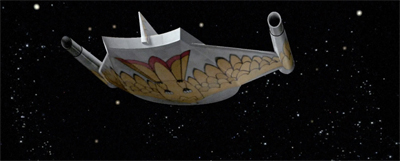
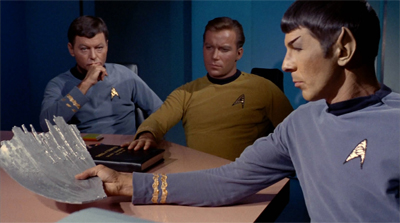
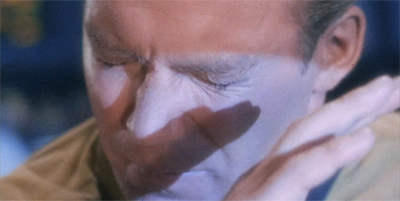


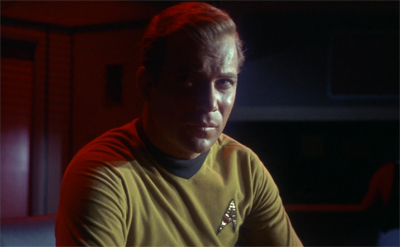

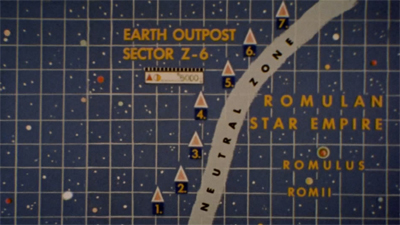
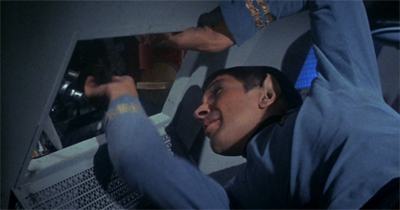

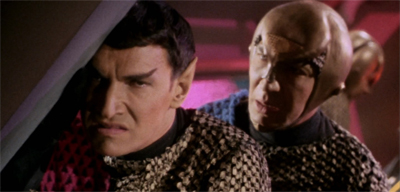
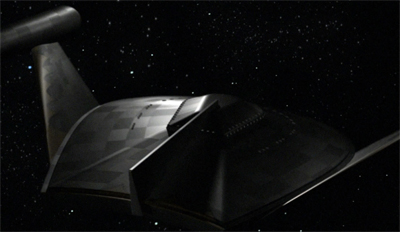

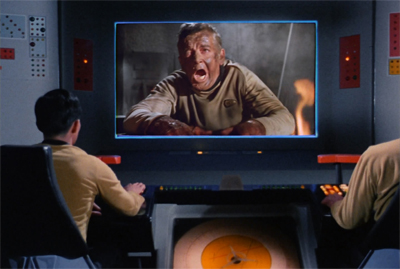
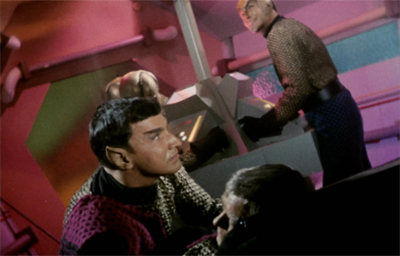
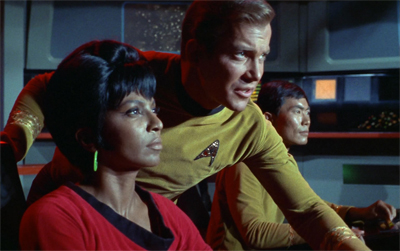
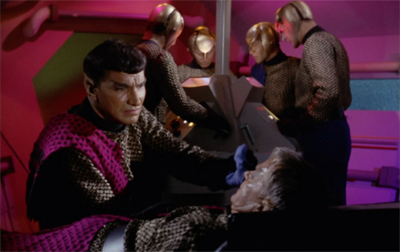


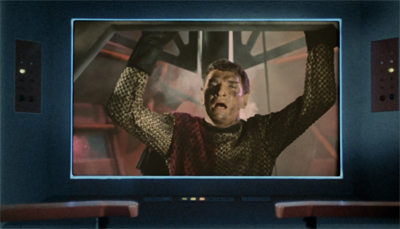

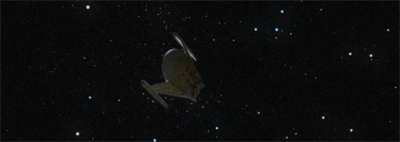





Last night I watched “Balance of Terror” for the first time in well over a decade. I was pleasantly surprised at just how good it was, how it held up to my memories of watching it so long ago. Paul Schneider’s script is really solid & nuanced. The direction by Vincent McEveety is absolutely fantastic, suffused with tension & atmosphere.
I was also genuinely shocked by just how good William Shatner was in this episode. It’s such a cliché in the 21st century that Shatner is famous (or perhaps infamous) for his overacting & scenery-chewing. So it’s very revealing to watch an episode like “Balance of Terror” and see such a low-key, subdued, thoughtful performance from him.
It’s a phenomenal piece of television.
This is an excellent analysis of Balance of Terror and great background information. Thank you.
Great quote: ” If the Vulcans are the best in us, the Romulans represent perhaps the worst.”
I wrote a short essay (450 words) on Balance of Terror called “The Doctrine of Proportional Response.” If you would like to read it, I am open to any feedback: https://christopherjohnlindsay.wordpress.com/2017/04/29/star-trek-balance-of-terror/
Thanks for the kind words, Chris!
Great review. Perhaps my all ime favorit episode of the entire franchise.
“Both ships are the “flagship” of their respective power.”
Are you sure? I don’t think Enterprise was ever treated as being any different from all the other Constitution class ships except by our main characters for obvious personal reasons.
It might have been established after the fact, but I guess I’d always taken for granted that the Enterprise was the Federation’s flagship for reasons of historical importance. (Picard’s Enterprise-D was definitely and repeatedly identified as the flagship. Enterprise establishes the historical importance of the title. The speed at which Starfleet keeps churning out replacements suggests that there’s something to it.)
Mark LENARD, not Mark Leonard.
Should be corrected now, cheers.